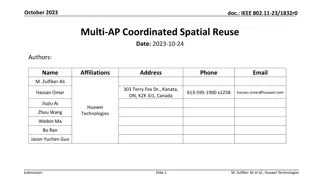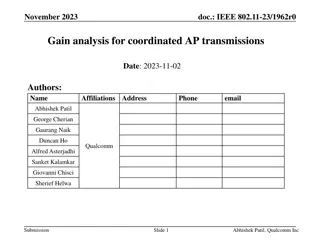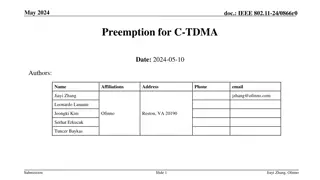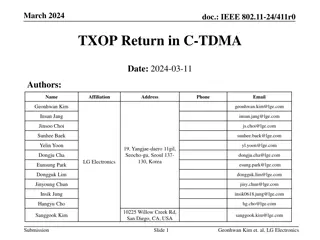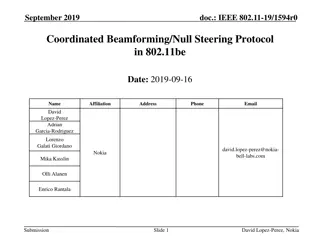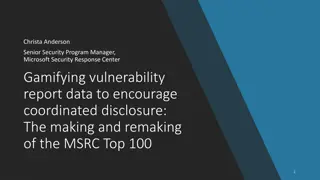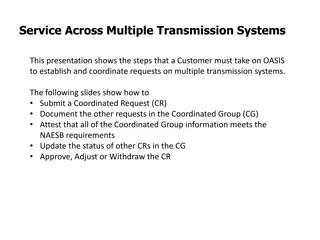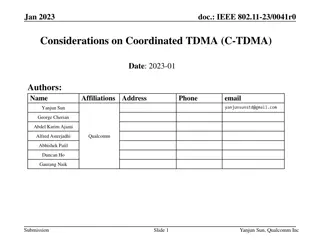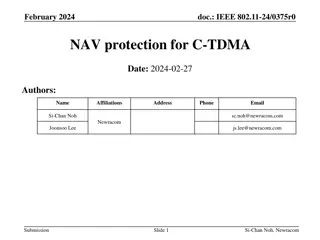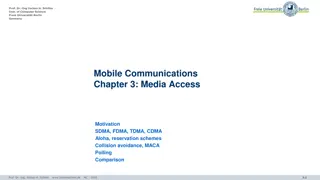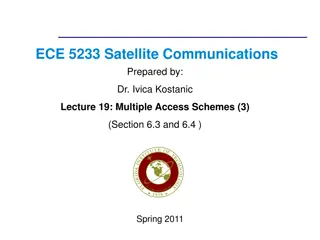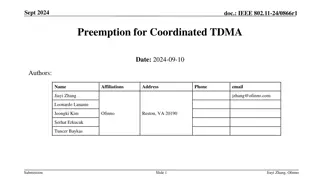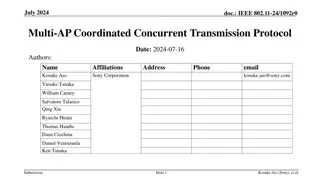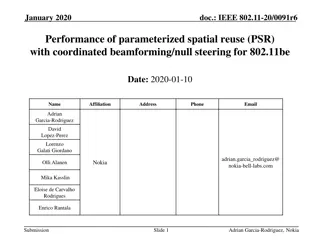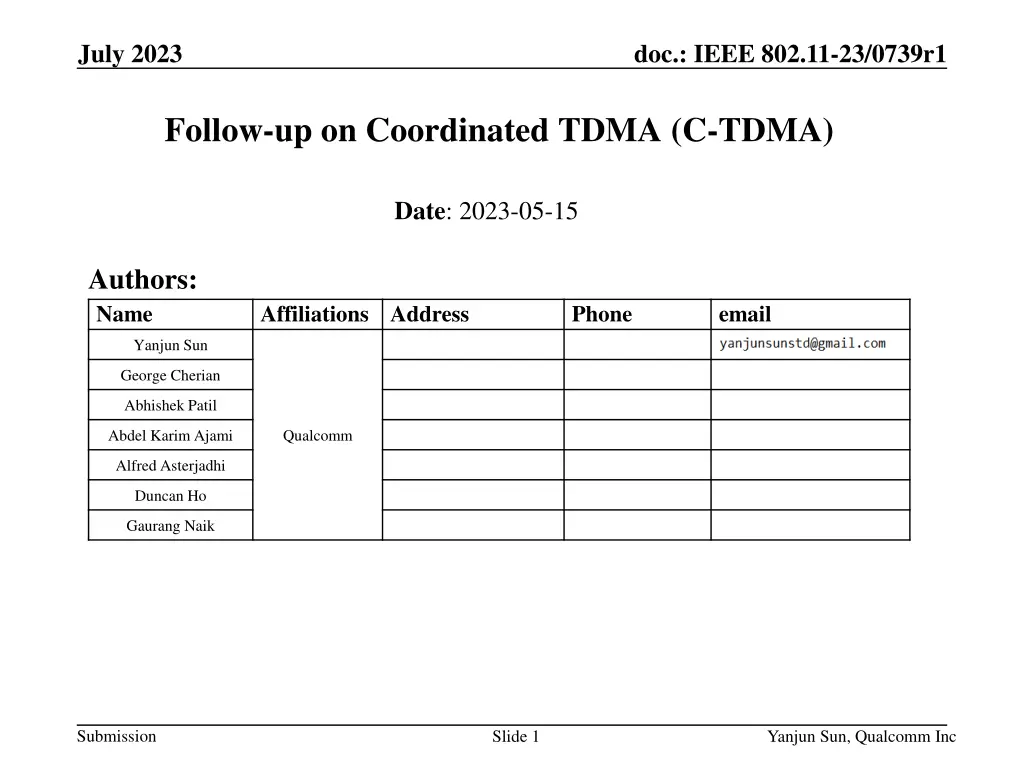
IEEE 802.11-23/0739r1 Follow-up on Coordinated TDMA Challenges
Explore challenges in handling processing delays, hidden APs, and TXOP return in Coordinated TDMA for IEEE 802.11-23/0739r1. Solutions like extra padding for delays and notification frames for hidden APs are discussed.
Download Presentation

Please find below an Image/Link to download the presentation.
The content on the website is provided AS IS for your information and personal use only. It may not be sold, licensed, or shared on other websites without obtaining consent from the author. If you encounter any issues during the download, it is possible that the publisher has removed the file from their server.
You are allowed to download the files provided on this website for personal or commercial use, subject to the condition that they are used lawfully. All files are the property of their respective owners.
The content on the website is provided AS IS for your information and personal use only. It may not be sold, licensed, or shared on other websites without obtaining consent from the author.
E N D
Presentation Transcript
July 2023 doc.: IEEE 802.11-23/0739r1 Follow-up on Coordinated TDMA (C-TDMA) Date: 2023-05-15 Authors: Name Affiliations Address Phone email Yanjun Sun George Cherian Abhishek Patil Abdel Karim Ajami Qualcomm Alfred Asterjadhi Duncan Ho Gaurang Naik Submission Slide 1 Yanjun Sun, Qualcomm Inc
July 2023 doc.: IEEE 802.11-23/0739r1 Objective Background Previous contributions in UHR for enabling C-TDMA aim to reuse EHT s TXS framework (see [1, 2]) However, the details are yet to be discussed Objective Identify TXS functionalities that may need further expansion, in order to make them work across APs Items to discuss in this contribution: 1. Handling different processing delays at APs 2. Handling hidden APs 3. TXOP return among APs Submission Slide 2 Yanjun Sun, Qualcomm Inc.
July 2023 doc.: IEEE 802.11-23/0739r1 Handling Different Processing Delays at APs Challenge: as discussed in [1], an UHR AP may need additional processing delays compared to a non-AP STA due to: The difference in architecture More complex scheduling decisions and higher workload Candidate solutions: Option 1: Use extra padding to account for the additional processing time when sharing a TXOP Pros: Same as existing schemes Cons: Increased airtime usage for padding transmission which reduces the networks' efficiency Option 2: Advance/upfront notification to the shared AP on schedule allocation via a dedicated frame Pros: Works for all scenarios regardless of expected processing delays Sharing AP can schedule a shared AP or serve its own BSS accounting for the processing delays after transmitting the notification frame Cons: Need to define new signaling (namely the notification frame) Submission Slide 3 Yanjun Sun, Qualcomm Inc.
July 2023 doc.: IEEE 802.11-23/0739r1 Handling Hidden APs Background: during the discussion of C-TDMA [1, 2], members suggested to keep the protocol flexible to schedule one or more shared APs Challenge: When shared APs are hidden from each other, it can disrupt the C-TDMA sequence and reduce reliability 3. AP1 uses the shared TXOP AP1 (shared AP) 2. Shares to AP1 (not setting NAV to allow AP1 to trigger uplink transmission from 11ax/be STAs) 5. AP2 cannot get back control of the TXOP due to the transmission from AP3 AP1 is hidden from AP3 1. Win a TXOP AP2 (sharing AP) 4. Mistakenly believes the medium is idle, and start parallel TX Time AP3 (shared AP) Candidate solution: A sharing AP transmits a dedicated frame (e.g., notification, i.e., same as option 2 of previous slide) to notify the neighboring AP(s) to defer contending based on the schedule 3. AP1 uses the shared TXOP AP1 (shared AP) 2. Share to AP1 (not setting NAV to allow AP1 to trigger uplink transmission from 11ax/be STAs) 4. AP2 gets control and shares to AP3 1. Notification AP1 is hidden from AP3 AP2 (sharing AP) Defer contention based on the Notification 5. AP3 uses the shared TXOP Time AP3 (shared AP) Submission Slide 4 Yanjun Sun, Qualcomm Inc.
July 2023 doc.: IEEE 802.11-23/0739r1 TXOP return among APs Recap: EHT s TXS framework enables TXOP sharing with an associated STA and provides a mechanism for TXOP return TXS mode 1 is meant for uplink (UL) transmission and TXOP return at the sharing AP is based on not receiving any uplink (UL) frames for a PIFS time from the STA with whom the TXOP was shared. TXOP mode 2 can be used for p2p and TXOP return at the sharing AP is based on receiving a QoS Null or QoS Data frame containing a CAS Control field indicating return of the TXOP. This mode may be more suited for AP-to-AP TXOP sharing, as it allows the shared TXOP to be used for PPDUs not addressed to the sharing AP Challenge: QoS Null/QoS Data Frames with CAS Control can be exchanged only between associated STAs (subject to their capabilities). Hence, this TXOP return mechanism may be challenging for AP-2-AP TXOP-sharing Proposal: for TXOP return, to find baseline procedures that don t require association among APs or capability knowledge Submission Slide 5 Yanjun Sun, Qualcomm Inc.
July 2023 doc.: IEEE 802.11-23/0739r1 CF-End for TXOP Return in C-TDMA If a shared AP (AP2) wants to return the TXOP before the end of the shared TXOP Send a CF-end frame with TA set to the shared AP (AP2) and Duration set to 0 If the sharing AP (AP1) receives this CF-End frame during the TXOP shared to AP2, the sharing AP may use/share the remaining TXOP in SIFS/PIFS MU-RTS TXS' for AP2 DATA to STA1 TXOP Owner Share TXOP to AP2 AP1 TXOP return to AP1 BA to AP1 STA1 CF-End TA=AP 2 CTS to AP1 DATA to STA2 AP2 (shared) BA to AP2 STA2 Time allocated to AP2 for DL/UL TB PPDU TXOP won by AP1 Submission Slide 6 Yanjun Sun, Qualcomm Inc.
July 2023 doc.: IEEE 802.11-23/0739r1 Will CF-End based TXOP return have backward compatibility issue? 11meD3.0P1911L38: The TXOP holder that transmits a CF-End frame shall not initiate any further frame exchange sequences within the current TXOP. This rule prohibits a shared AP (AP2) from using the rest of the TXOP But it doesn t block the sharing AP that hasn t transmitted a CF-end 11meD3.0P1911L50: In a non-DMG BSS, a non-S1G non-HE STA(11ax) shall interpret the reception of a CF-End frame as a NAV reset, i.e., it resets its NAV to 0 at the end of the PPDU containing this frame. After receiving a CF-End frame with a matching BSSID(TA) without comparing Individual/Group bit, an AP may respond by transmitting a CF-End frame after SIFS." This is a precedence for a sharing AP to continue using the TXOP after receiving a CF-end Submission Slide 7 Yanjun Sun, Qualcomm Inc.
July 2023 doc.: IEEE 802.11-23/0739r1 Summary This contribution tried to identify TXS functionalities that may need further expansion and candidate solutions: Challenge1: Handling different processing delays at APs Proposal 1: use padding in MU-RTS TXS Trigger frame Proposal 2: introduce a new frame to indicate schedule allocation upfront Challenge2: Handling hidden APs Proposal: introduce a new frame to indicate schedule allocation upfront Challenge3: TXOP return between APs Proposal: reuse existing CF-end frame for TXOP return Submission Slide 8 Yanjun Sun, Qualcomm Inc.
July 2023 doc.: IEEE 802.11-23/0739r1 References [1] Yanjun Sun and et al. (Qualcomm), Considerations on Coordinated TDMA (C-TDMA) , 23/0041r0, Jan 2023. [2] Dibakar Das and et al. (Qualcomm), C-TDMA procedure in UHR , 23/0216r0, Apr 2023. Slide 9 Submission Yanjun Sun, Qualcomm Inc.

